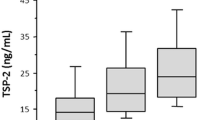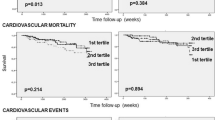Abstract
Purpose
Cardiovascular diseases are the leading causes of mortality in chronic kidney disease. Spondin-2 (SP-2), an intrinsic cardio-protective factor, prevents maladaptive remodeling. We aimed to determine the relation between serum SP-2 levels and cardiac morphology along with inflammatory parameters in hemodialysis (HD) patients.
Method
The study comprised a total of 95 patients (61 females) receiving HD treatment three times a week for at least 6 months, and a control group consisting of age and gender matched 62 subjects (34 females). SP-2 levels were determined by ELISA. Echocardiography, 24-h ambulatory blood pressure monitoring, and carotid artery intima-media thickness (CIMT) measurement were performed in all subjects. The relation of serum SP-2 levels with CIMT, echocardiographic parameters, CRP, and absolute neutrophil-to-lymphocyte count ratio (NLR) was evaluated by correlation analysis.
Results
SP-2 levels were found to be significantly higher in the HD group than the control group (16.660 [8.719–20.938] vs. 3.988 [2.702–8.042] ng/L; P < 0.001). CIMT, CRP, and NLR were also higher in HD group (P < 0.005, P < 0.001, and P < 0.001, respectively). Significantly positive correlation was found between SP-2 and left ventricular mass, left ventricular mass index, CRP, and NLR, but no correlation was determined between SP-2 and CIMT. SP-2 was not statistically significant variable for the determination of LVH in univariate logistic regression analysis [Wald = 2.375; OR (95% CI) = 1.000 (0.999–1.000), P = 0.123].
Conclusion
Serum SP-2 levels were higher in HD patients compared to the population with normal renal functions. The results suggest that SP-2, an uremic toxin, might be effective over a complex pathway in the inflammatory process and in the pathogenesis of cardiovascular diseases of patients under HD treatment.
Similar content being viewed by others
References
Dalla Vestra M, Mussap M, Gallina P, Bruseghin M, Cernigoi AM, Saller A, Plebani M, Fioretto P (2005) Acute-phase markers of inflammation and glomerular structure in patients with type 2 diabetes. J Am Soc Nephrol 16:S78–S82
Wolf G (2004) New insights into the pathophysiology of diabetic nephropathy: from haemodynamics to molecular pathology. Eur J Clin Invest 34:785–796
Higashijima S, Nose A, Eguchi G, Hotta Y, Okamoto H (1997) Mindin/F-spondin family: novel ECM proteins expressed in the zebrafish embryonic axis. Dev Biol 192:211–227
Wei Jia H, Li, He Y-W (2005) The extracellular matrix protein mindin serves as an integrin ligand and is critical for inflammatory cell recruitment. Blood 106:3854–3859
Kahvecioglu S, Guclu M, Ustundag Y, Gul CB, Dogan I, Dagel T, Esen B, Esen SA, Celik H, Esen I (2015) Evaluation of serum spondin 2 levels in the different stages of type 2 diabetic nephropathy. Nephrology 20:721–726
Murakoshi M, Tanimoto M, Gohda T, Hagiwara S, Takagi M, Horikoshi S, Tomino Y (2011) Mindin: a novel marker for podocyte injury in diabetic nephropathy. Nephrol Dial Transplant 26:2153–2160
Berk BC, Fujiwara K, Lehoux S (2007) ECM remodeling in hypertensive heart disease. J Clin Invest 117:568–575
Bian ZY, Wei X, Deng S, Tang QZ, Feng J, Zhang Y, Liu C, Jiang DS, Yan L, Zhang LF, Chen M, Fassett J, Chen Y, He YW, Yang Q, Liu PP, Li H (2012) Disruption of mindin exacerbates cardiac hypertrophy and fibrosis. J Mol Med 90:895–910
Yan L, Wei X, Tang QZ, Feng J, Zhang Y, Liu C, Bian ZY, Zhang LF, Chen M, Bai X, Wang AB, Fassett J, Chen Y, He YW, Yang Q, Liu PP, Li H (2011) Cardiac-specific mindin overexpression attenuates cardiac hypertrophy via blocking AKT/GSK3beta and TGF-beta1-Smad signalling. Cardiovasc Res 92:85–94
Parry R, Schneider D, Hudson D, Parkes D, Xuan JA, Newton A, Toy P, Lin R, Harkins R, Alicke B, Biroc S, Kretschmer PJ, Halks-Miller M, Klocker H, Zhu Y, Larsen B, Cobb RR, Bringmann P, Roth G, Lewis JS, Dinter H, Parry G (2005) Identification of a novel prostate tumor target, mindin/RG-1, for antibody-based radiotherapy of prostate cancer. Cancer Res 65:8397–8405
Navarro JF, Mora C (2005) Role of inflammation in diabetic complications. Nephrol Dial Transplant 20:2601–2604
Mora C, Navarro JF (2006) Inflammation and diabetic nephropathy. Curr Diab Rep 6:463–468
Demircan N, Safran BG, Soylu M, Ozcan AA, Sizmaz S (2006) Determination of vitreous interleukin-1 (IL-1) and tumour necrosis factor (TNF) levels in proliferative diabetic retinopathy. Eye 20:1366–1369
Lim AK, Tesch GH (2012) Inflammation in diabetic nephropathy. Mediat Inflamm 2012:146–154
Tesch GH (2008) MCP-1/CCL2: a new diagnostic marker and therapeutic target for progressive renal injury in diabetic nephropathy. Am J Physiol Ren Physiol 294:F697–F701
He YW, Li H, Zhang J et al (2004) The extracellular matrix protein mindin is a pattern-recognition molecule for microbial pathogens. Nat Immunol 5:88–97
Kahan T, Bergfeldt L (2005) Left ventricular hypertrophy in hypertension: its arrhythmogenic potential. Heart 91:250–256
Zhu LH, Wang A, Luo P, Wang X, Jiang DS, Deng W, Zhang X, Wang T, Liu Y, Gao L, Zhang S, Zhang X, Zhang J, Li H (2014) Mindin/Spondin 2 inhibits hepatic steatosis, insulin resistance, and obesity via interaction with peroxisome proliferator-activated receptor α in mice. J Hepatol 60:1046–1054
Dogan T, Yetim M, Celik O, Kalcık M, Ozcan O, Dogan I, Erenler K, Bekar L, Karavelioglu Y (2017) Investigation of mindin levels in hypertensive patients with left ventricular hypertrophy and QRS fragmentation on electrocardiography. Acta Cardiol 21:1–6
Zhu LH, Huang L, Zhang X, Zhang P, Zhang SM, Guan H, Zhang Y, Zhu XY, Tian S, Deng K, Li H (2015) Mindin regulates vascular smooth muscle cell phenotype and prevents neointima formation. Clin Sci 129:129–145
Sarafidis PA, Loutradis C, Karpetas A, Tzanis G, Piperidou A, Koutroumpas G, Raptis V, Syrgkanis C, Liakopoulos V, Efstratiadis G, London G, Zoccali C (2017) Ambulatory pulse wave velocity is a stronger predictor of cardiovascular events and all-cause mortality than office and ambulatory blood pressure in hemodialysis patients. Hypertension 70:148–157
Author information
Authors and Affiliations
Corresponding author
Ethics declarations
Conflict of interest
Authors declare no conflict of interest.
Ethical approval
All procedures performed in studies involving human participants were in accordance with the ethical standards of the Erciyes University institutional research committee and with the 1964 Helsinki declaration and its later amendments or comparable ethical standards.
Informed consent
Informed consent was obtained from all individuals included in this study.
Rights and permissions
About this article
Cite this article
Dogan, I., Yetim, M., Dogan, T. et al. Relation of serum spondin-2 levels with cardiac morphology and inflammatory parameters in hemodialysis patients. Int Urol Nephrol 50, 2091–2097 (2018). https://doi.org/10.1007/s11255-018-1996-5
Received:
Accepted:
Published:
Issue Date:
DOI: https://doi.org/10.1007/s11255-018-1996-5




